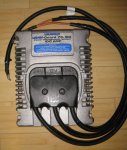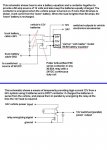Trango
Member
- 735
- 22
- 18
- Location
- Boulder, CO
Hi Guys
I am starting to wire the electrical on my project, and I'm torn between doing one of two systems. I'd love some feedback, and I invite you to comment either on the synopsis or any of the scenarios in the details of potential options.
Thanks for any feedback!
Synopsis:
I am torn between using a battery equalizer to achieve 12v off of a 24v system OR using a combo of a 12v alternator and a 24v alternator (similar to a CUCV system). The engine is a repower, originally 12v and stuck into my 24v chassis.
Details of potential options:
Scenario 1
1. Two Batteries, one single 24v alternator, with a battery equalizer to both handle 12v loads (starter and run solenoids - civvy engine).
Pros
- Simplicity, single alternator and no extra brackets or belts to fab or deal with
Cons
- Single alternator (single point of failure)
- If either battery fails, the system would likely become imbalanced and cause errors.
- I would have to rewire a fair amount of the engine harness, as the 12v output of the current alternator
Scenario 2
2. Two batteries, one 24v and one 12v alternator. 12v alternator feeds the "low side" battery (the one whose negative is connected to chassis ground), 24v alternator feeds the "high side" battery.
Pros
- Not sure if I can or should use my battery equalizer (this is an open question I have).
- 2 alternators would create, in the event that a single alternator failed, at least temporary redundancy on the 12v duties (starting and running, which are the most critical)
- In this particular case and with this engine, I wouldn't have to break alot of the existing wiring on my engine by removing the 12v alternator
Cons
- Need to fab a new bracket and install belt for the 24v alternator, but there is an extra drive pulley for it and it wouldn't be that hard.
- If the 12v alternator fails, it would mean battery death since this will be an imbalanced system
Scenario 2a
2a. There is a variation on "2.", which is two completely seperate battery systems: one 24v system from two batteries, and one 12v system, for a total of three 12 v batteries).
Pros
Would allow for the most redundancy and options in the event of failure.
Cons
Complex, expensive (batteries) and would crowd the battery box.
Any thoughts? I am a sponge on this topic.
Best,
Bob
I am starting to wire the electrical on my project, and I'm torn between doing one of two systems. I'd love some feedback, and I invite you to comment either on the synopsis or any of the scenarios in the details of potential options.
Thanks for any feedback!
Synopsis:
I am torn between using a battery equalizer to achieve 12v off of a 24v system OR using a combo of a 12v alternator and a 24v alternator (similar to a CUCV system). The engine is a repower, originally 12v and stuck into my 24v chassis.
Details of potential options:
Scenario 1
1. Two Batteries, one single 24v alternator, with a battery equalizer to both handle 12v loads (starter and run solenoids - civvy engine).
Pros
- Simplicity, single alternator and no extra brackets or belts to fab or deal with
Cons
- Single alternator (single point of failure)
- If either battery fails, the system would likely become imbalanced and cause errors.
- I would have to rewire a fair amount of the engine harness, as the 12v output of the current alternator
Scenario 2
2. Two batteries, one 24v and one 12v alternator. 12v alternator feeds the "low side" battery (the one whose negative is connected to chassis ground), 24v alternator feeds the "high side" battery.
Pros
- Not sure if I can or should use my battery equalizer (this is an open question I have).
- 2 alternators would create, in the event that a single alternator failed, at least temporary redundancy on the 12v duties (starting and running, which are the most critical)
- In this particular case and with this engine, I wouldn't have to break alot of the existing wiring on my engine by removing the 12v alternator
Cons
- Need to fab a new bracket and install belt for the 24v alternator, but there is an extra drive pulley for it and it wouldn't be that hard.
- If the 12v alternator fails, it would mean battery death since this will be an imbalanced system
Scenario 2a
2a. There is a variation on "2.", which is two completely seperate battery systems: one 24v system from two batteries, and one 12v system, for a total of three 12 v batteries).
Pros
Would allow for the most redundancy and options in the event of failure.
Cons
Complex, expensive (batteries) and would crowd the battery box.
Any thoughts? I am a sponge on this topic.
Best,
Bob
Last edited:







